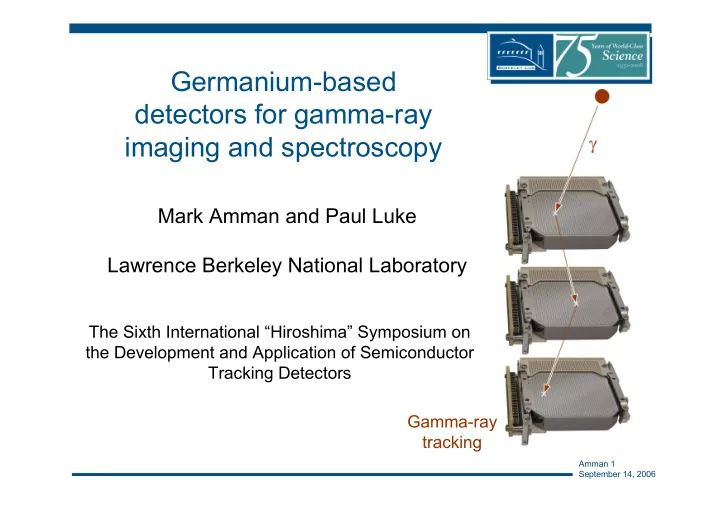

Germanium-based detectors for gamma-ray imaging and spectroscopy Mark Amman and Paul Luke Lawrence Berkeley National Laboratory The Sixth International “Hiroshima” Symposium on the Development and Application of Semiconductor Tracking Detectors Gamma-ray tracking Amman 1 September 14, 2006
Outline • Ge detectors and Gamma-ray imaging • Detector fabrication technologies • Amorphous-semiconductor contacts • Bipolar blocking and barrier heights • 3-d position detection • Fine electrode segmentation • Issues: charge sharing, temperature cycling Amman 2 September 14, 2006
Detector material: Why Ge? • High Z • Large commercially available crystals High efficiency 10 cm diameter boules • Large depletion lengths > 2 cm • Near perfect charge collection µτ e , µτ h >10 cm 2 /V → L > 10 4 cm Excellent energy • Favorable charge generation statistics resolution < 0.2%FWHM @ 1.3MeV 1 / 2 ( ) E 2 . 35 F E , Δ = ε Statistics γ F Ge Fano factor 0 . 08 eV ≡ = G e e - h pair creation energy 2 . 97 eV ε ≡ = However, cooling to near LN temperatures required because of small band gap Amman 3 September 14, 2006
Gamma-ray imaging 2-d position Multi-hole Pin-hole sensitive collimator aperture detector 2-d position 2-d position Coded sensitive sensitive aperture detector #1 detector #2 Need position as well as spectroscopic information Amman 4 September 14, 2006
Standard Ge technology Implanted n+ contacts do not withstand high fields and are not reproducible Metal surface barrier contacts are not rugged and are p-type Amman 5 September 14, 2006
Segmented electrical contacts Problems: • Thick Li and post fabrication diffusion limit pitch to ~ 1 mm • Interstrip surfaces lack passivation Fine pitches possible on B- implanted contact Amman 6 September 14, 2006
Amorphous semiconductor contacts Advantages: • Bipolar blocking contacts • Self passivating • Simple fabrication process • Thin contact dead layer • Fine pitches achievable W. Hansen and E. Haller, IEEE TNS 24, 61 (1977). P.N. Luke, et al., IEEE TNS 39, 590 (1992). Amman 7 September 14, 2006
Bipolar blocking behavior Full depletion Full depletion Amman 8 September 14, 2006
Barrier heights n+ / p-type Ge / a-Ge device Fit to Δ I = AT 2 e - φ /kT Amman 9 September 14, 2006
Barrier heights Contact φ e [eV] φ h [eV] φ e + φ h [eV] ρ [ Ω -cm] a-Ge (Ar) 0.36 0.34 0.70 ~10 6 -10 8 a-Ge (Ar+17.5% H 2 ) 0.29 0.39 0.68 ~10 11 a-Si (Ar) 0.39 0.28 0.67 Barrier heights depend on material and deposition parameters Higher film resistivity of a-Ge (Ar+17.5% H 2 ) over that of a-Ge (Ar) typically desired to obtain high inter-electrode impedance Amman 10 September 14, 2006
Barrier heights Contact φ e [eV] φ h [eV] φ e + φ h [eV] ρ [ Ω -cm] a-Ge (Ar) 0.36 0.34 0.70 ~10 6 -10 8 a-Ge (Ar+17.5% H 2 ) 0.29 0.39 0.68 ~10 11 a-Si (Ar) 0.39 0.28 0.67 Choose this combination to minimize leakage current Amman 11 September 14, 2006
Barrier heights Amman 12 September 14, 2006
3-d position detection M. Momayezi, et al., SPIE 3768, 530 (1999). M. Amman and P.N. Luke, NIM A 452, 155 (2000). Amman 13 September 14, 2006
Detector example 1.5 cm 8 cm Orthogonal-strip detectors produced for the Nuclear Compton Telescope (Steve Boggs at UC Berkeley Space Sciences Laboratory) 37 strips each side, 2 mm strip pitch, a-Ge (Ar, 17.5% H 2 ) contacts 6 detectors produced to date (12 ultimately required) Amman 14 September 14, 2006
Detector example Compton circle projection NCT Prototype 60 Co (1.173 MeV) source (50 µ Ci, 5 m, ~2 hrs.) Courtesy: Steve Boggs, SSL Maximum likelihood Amman 15 September 14, 2006
Fine-pitched segmentation Strip detector produced for synchrotron x-ray applications (Daresbury Laboratory) 1024 strips, 50 µ m strip pitch, 1 mm thick Amman 16 September 14, 2006
Issue: Charge sharing Amman 17 September 14, 2006
Issue: Charge sharing Amman 18 September 14, 2006
Other solutions: • Smaller gaps • Field shaping electrodes: M. Amman and P.N. Luke, NIM A 452, 155 (2000). • Etch away amorphous layer between electrodes: D. Protic and T. Krings, IEEE TNS 50, 998 (2003). More work to be done … Amman 19 September 14, 2006
Improvements needed • Temperature cycling stability • Optimization of a-Ge/Ge/a-Si configuration • Charge sharing reduction • Side surface state control? Amman 20 September 14, 2006
Recommend
More recommend